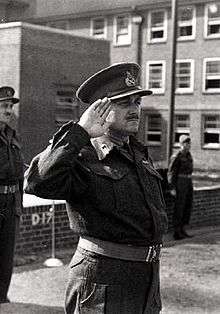Chiefs of Staff (Canada)
The Chiefs of Staff Committee was a collection of the heads of each military service in Canada prior to the beginning of Unification: the Royal Canadian Navy, the Canadian Army and the Royal Canadian Air Force. The Chiefs of Staff Committee consisted of the Chief of the Naval Staff, the Chief of the General Staff, the Chief of the Air Staff and a Chairman who held a rank one level higher than the service heads.[1] While Unification did not officially take place until 1968, the committee was replaced by the Armed Forces Council in 1964 after the publication of a Defence White Paper which proposed significant changes to the command structure of Canada's armed forces. The position of Chairman was replaced by the position of Chief of the Defence Staff with greatly expanded powers and functions.
References
- Canadian Army (1949–1964), "Fonds of the Chief of the General Staff", in Department of National Defence (ed.), Histories > DHH Historical Research Centre > Research > DHH Archive Database > Reports > Miscellaneous Reports/Documents > DHH Archival Database Extract (PDF), Ottawa: Queen's Printer for Canada, p. 40, 97/10, retrieved 22 September 2009
| No. | Chairmen of the Chiefs of Staff Committee | Took office | Left office | Time in office | Home Province | Defence branch | Appointed by | Prime Minister | Ref | |
|---|---|---|---|---|---|---|---|---|---|---|
| 1 | General Charles Foulkes (1903–1969) | 1951 | 1960 | 8–9 years | Canadian Army | Georges Vanier | Louis Saint Laurent | [1] | ||
| 2 | General Frank Robert Miller (1908–1997) | 1960 | 1964 | 3–4 years | Royal Canadian Air Force | Georges Vanier | Lester B. Pearson | [2] |
- "Canada’s 25 Most Renowned Military Leaders". Legion Magazine, May 1, 2011 by Dan Black
- Robert Miller. The Canadian Encyclopedia.

